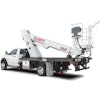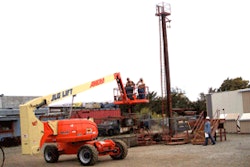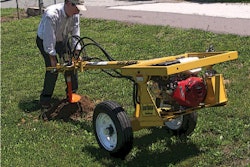You’ve got a million things on your mind. The weather is about to turn ugly. You want to hurry up and get to the jobsite and finish your work so you can go home and watch the game on TV. While you know safety is important, it’s not on the top of your mind right now. But, it should be. Safety should always be a priority - for you and your customers.
When accidents or problems occur, they usually are the result of someone being in a hurry, says John DeGeorge, national sales manager for Eager Beaver Trailers. Typically, he says no one intends to ignore safety and get reckless with a trailer.
"Drivers are professionals - they understand that if they make a mistake, not only could they get hurt, but they could hurt somebody else," DeGeorge says. "All it takes is a piece of equipment to come off and go through someone’s window ... and the car goes off the road."
If you ignore safety, Gary Knudsen, sales representative for Towmaster Trailers Inc., says, "You might think you’re getting by, but there’s always a consequence."
Keeping safety in mind, you and your customers can avoid mistakes. One way to do this is by going through a mental checklist or even checking off a list on paper. There are many precautions that need to be taken.
Watch your weight
Safety begins before the equipment is on the trailer. First and foremost is knowing how much weight a trailer can really tow.
"Most people overload their trailers and I don’t think they realize it," Knudsen says. "They buy or rent a trailer that fits the weight of the equipment that needs to be towed, but they forget about the weight added by various attachments or tools."
In addition to the load weight, you also have to factor in the trailer’s weight. If a trailer weighs 10,000 pounds and the gross vehicle weight rating (found on the hitch) is 40,000 pounds, that means you can put 30,000 pounds of payload on the trailer, DeGeorge explains.
Knudsen advises everyone to avoid towing the maximum weight. Instead, he suggests habitually using a trailer to about 80 percent of its capacity. As a result, he says the trailer (and especially tires) will last longer. Anytime something isn’t used 100 percent, it’s going to last longer and have better results, he says. Overall, vehicle control also will be better, he adds.
Knowing the rated towing capacity of the trailer is not enough. You also need to know the rated towing capacity of the vehicle that will be towing the trailer, Knudsen says. Make sure the vehicle can actually tow the trailer and the load by checking the owner’s manual or contacting the vehicle manufacturer or dealer, he says.
Hitch capacity, which is not always as high as the towing capacity, also is important. Here again, the owner’s manual or dealer should have the answer.
Finally, know the rated capacity of the securing devices (D-rings, chains, chain binders). All chains and binders should have ratings on them and binder chains should be Grade 70 or higher, DeGeorge says.
Seek security
After you have established the weight ratings are suitable, and you’re getting ready to load the trailer, make sure the trailer is on level ground rather than on a hill or at an incline.
There are various consequences to not being on level ground. One, Knudsen points out, is that if a trailer is not level, the load on the trailer might slide sideways.
Also, make sure the ground is firm, that the wheels don’t get stuck in mud or snow.
If you’re using an electric brake trailer, remember it has no parking brakes. The wheels need to be locked, or chocked. Put chocks, or blocks, in front of and behind trailer tires to keep the trailer from moving.
Another common mistake is not tying down loads properly, Knudsen says. Throwing a chain or two across the front and back isn’t good enough. Each corner requires a separate chain and binder or strap, Knudsen says.
Four-point security requires four chains, four binders, says DeGeorge, noting Eager Beaver Trailers, along with John Deere and Crosby, updated their video for new trailer owners this summer to include the new federal guideline.
"If you’ve got a backhoe or something with a boom arm, you should have two more chain sets on to keep the boom or backhoe arm from moving," he adds. "Once you get all your equipment loaded on the trailer, you need to lower buckets and booms to the deck. If the boom has the ability to pivot left to right, it should have another set of chains."
If tools are transported on the trailer, they need to be secured, too. There shouldn’t be any loose items set in a bucket or placed in the front of the trailer, Knudsen says.
More common than perhaps anyone might think is forgetting to latch the ball coupler or lock the pintal, Knudsen says.
A contractor, for example, might have a pickup truck and not latch the trailer to the back of the truck. "All of a sudden, he goes to load the trailer and it pops the hitch apart and pokes the trailer into the back of the tow unit," he says.
When you drive a piece of equipment up on a trailer, DeGeorge says to make sure there are no electrical wires or obstructions above. You don’t want to hit a wire or something overhead.
Inspect thoroughly
You can never be too careful. Other checks you might want to include on a checklist are:
Brakes - Whether a trailer has air brakes or electric brakes, it doesn’t matter, you shouldn’t depend on them, the tow vehicle also must have good brakes.
If you have an electric brake trailer, before you tow your load down the road, manually pull the break-away pin out and try to drive away, DeGeorge says. The brakes should be on, you shouldn’t be able to drive down the road, he says.
Air pressure - Make sure the tires have enough air in them; they’re not soft.
Trailer bed and ramps - The trailer bed and ramps should be free of mud, snow and ice.
Boards - Visually inspect the trailer to make sure there are no loose or broken boards, rotten wood or stones on the deck.
"Sometimes stones can get tracked up in the tire," DeGeorge says. "You go down the road and a stone comes off and it goes through somebody’s windshield. That’s not good. When things like that happen, it gives everybody in the industry a bad name."
Oil - Most trailers have sight glasses in the axel so you can make sure you have plenty of oil and you’re not burning up the bearings.
"A lot of times these things will get damaged on the road and oil starts dripping out," DeGeorge says. "Nobody checks them. They just run them and run them until they burn up their bearings. At that point, you risk the trailer catching on fire."
Lights - Lights, too, should be checked to make sure they’re in good condition.
Line up
Once you have completed a thorough inspection, you’re ready to line up.
When driving on and off of a trailer, wheeled vehicles just need to go slow and steady. "Try not to go fast or jerk side to side, "Knudsen says. "Line up straight and go slow and steady."
On tracked machines, like an excavator, DeGeorge says, "you’re going to be offset to one side. As you’re pulling up, you need to look ahead on the trailer, find a board that you want to line up with and just stay right on it. It’s even better if you have a safety person to watch and help. A tracked machine is going to want to teeter at the beaver tail, where you start transitioning to the flat deck. At that point, a driver should be going very slowly to make sure one track of the machine doesn’t grab quicker than the other."
Slow and steadyWith equipment in place and a trailer in tow, you’re now driving a much longer vehicle, which requires more space when entering traffic and more time to accelerate and decelerate. You won’t be able to speed up as fast as you are used to. In fact, the deceleration, or stopping distance, can almost double if you have a heavy load behind a truck or pickup or an SUV, Knudsen points out.
When driving, keep the wheel steady, he says. "Don’t jerk the wheel back and forth," he says. "It’s just like a dog’s tail, it wags. If you are not steady, you can lose control."
Don’t override safetyIf you’re renting out a trailer, it’s no different than any other piece of equipment - make sure the person driving it away can operate it safely. Make sure they know how to safely load and unload it. DeGeorge at Eager Beaver concludes, "You can’t let the need to get the rental override safety."




















